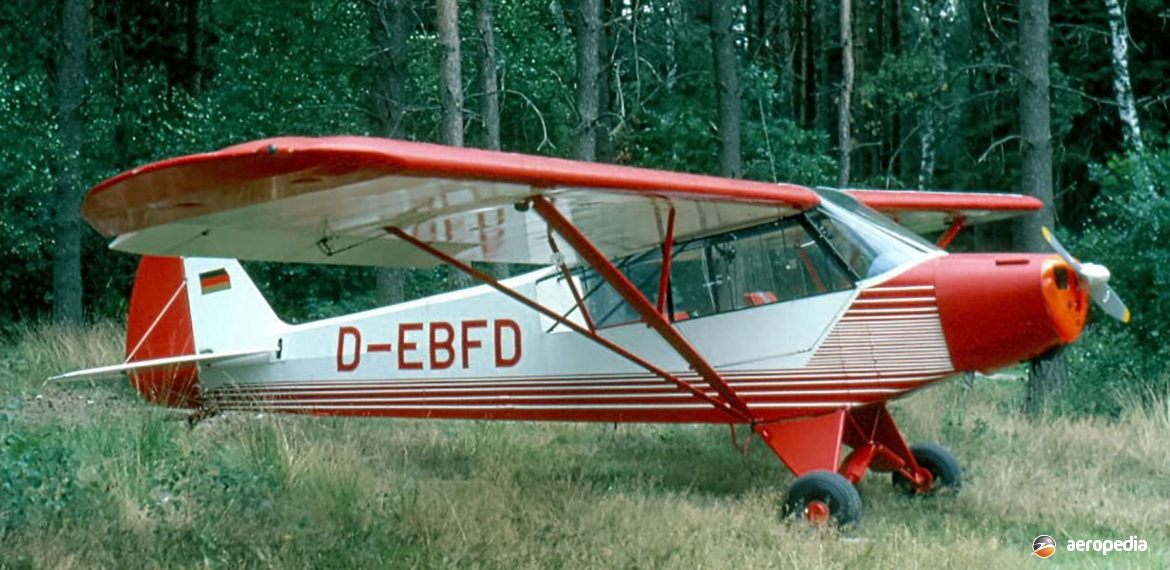Photograph:
Piper J-5 Cruiser D-EBFD at Celle-Arlon in Germany in June 1986 (David C Eyre)
Country of origin:
United States of America
Description:
Three-seat light touring monoplane
Power Plant:
One 75 kw (100 hp) Avco Lycoming O-235-C four-cylinder horizontally-opposed air-cooled engine
Specifications:
- Wingspan: 10.82 m (35 ft 6 in)
- Length: 6.86 m (22 ft 6 in)
- Height: 2.03 m (6 ft 8 in)
- Wing area: 16.63 m² (179 sq ft)
- Max speed: 177 km/h (110 mph)
- Cruising speed at 80% power at 914 m (3,000 ft): 161 km/h ((100 mph)
- Stalling speed: 72 km/h (45 mph)
- Initial rate of climb: 183 m/min (600 ft/min)
- Service ceiling: 4,570 m (15,000 ft)
- Cruising range at 80% power at 914 m (3,000 ft): 620 km (385 miles)
- Empty weight: 388 kg (855 lb)
- Loaded weight: 703 kg (1,550 lb)
History:
The J-5 Cruiser was a logical development of the earlier and very popular J-3 and J-4 series, designed to provide accommodation for three persons in lieu of two, this being achieved by a modest expansion of the fuselage width. Aimed at the market as a cheap multi-purpose aircraft, the type proved very popular, but production for civil purposes was curtailed by World War II. In May 1940 it was advertised as ”aviation’s lowest priced three-place airplane. Its wide rear seat comfortably accommodates two passengers. With compass, navigation lights and brakes standard equipment the Cruiser’s load-carrying ability, gas capacity and quick take-off adapt it to cross-country private flying, passenger-carrying and training. Lycoming geared or Continental 75 hp engine.” It was used to some extent by the US military services.
The first model was the J-5A, known as the ‘Cub Cruiser’, introduced in December 1939 and fitted with a 56 kw (75 hp) Continental engine. A total of 495 examples of this variant was built. In February 1941 the J-5B was introduced with the 75 kw (100 hp) Lycoming, and it became very popular. However, only 35 were built for private use when civil production ceased in favour of production for military purposes. The US Navy then ordered 100 examples of the J-5C, known as the HE-1, for ambulance work, carrying a pilot and a stretcher patient located in the rear fuselage under the decking, which had a hinged top. In 1943 the H designation was reserved for helicopters, and the HE-1 became the AE-1. If need be, two stretchers could be carried, one on top of the other. Examples also were supplied to the United States Marine Corps.
The wing framework was built up of solid spruce spar beams and Nicral metal wing-ribs, the leading-edges being covered with dural sheet and the completed unit covered with fabric. The fuselage was built of steel tubing faired to shape and fabric covered. After the war a large number of ex-military aircraft were obtained for civil use with private owners, and one of these was imported to New Zealand in 1986 by Charles Liddel. It was partially restored at Ardmore but the work was not completed and it was never flown in New Zealand. It was allotted the registration ZK-USN but this was not taken up. It was exported to the United Kingdom where work was completed and it was painted as a US Navy AE-1 ambulance in a yellow colour scheme with red crosses, eventually ending up in France.
Two J-5s have been imported for restoration at Tyabb, VIC. Imported from the US in 1987, these aircraft are c/n 5-1036 (ex PH-DKD), with a C85-12 engine, and the other c/n 5-1002, fitted with a C75-12 engine.

